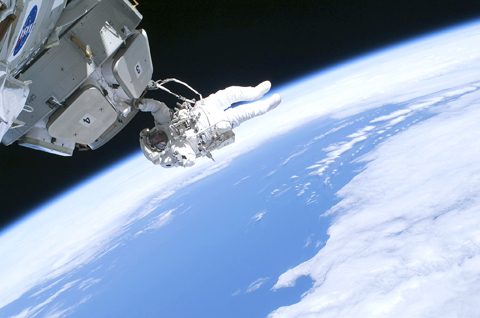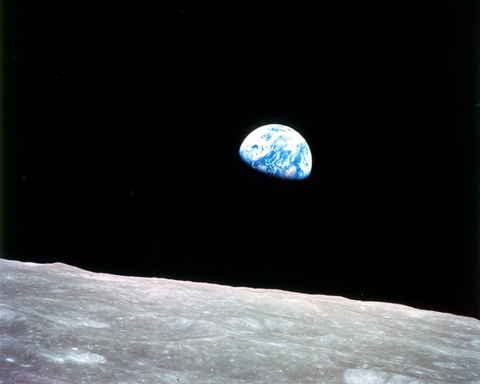Daniel Shenton should be the most irrational man in the world. As the new president of the Flat Earth Society, you’d imagine he would also think that evolution is a scam and global warming a myth. He should argue that smoking does not cause cancer and HIV does not lead to AIDS.
Yes, that Flat Earth Society, a group that has become a living metaphor for backward thinking and a refusal to face scientific facts. Yes, it is still going, and no, this isn’t an early April fool.
In fact, Shenton turns out to have resolutely mainstream views on most issues. The 33-year-old American, originally from Virginia but now living and working in London, is happy with the work of Charles Darwin. He thinks the evidence for man-made global warming is strong, and he dismisses suggestions that his own government was involved with the 9/11 terrorist attacks.

PHOTO: REUTERS
He is mainstream on most issues, but not all. For when Shenton rides his motorbike, he says it is not gravity that pins him to the road, but the rapid upward motion of a disc-shaped planet. Countries, according to him, spread across this flat world as they appear to do on a map, with Antarctica as a ring of mountains strung around the edge. And, yes, you can fall off.
If you thought that flat Earthism was gone, think again. The scientific evidence is stacked against Shenton, obviously, just as it is against those who think global warming is a hoax and that the dead stalk the Earth as ghosts — but that doesn’t appear to trouble him in the least.
“There is no unified flat Earth model,” Shenton suggests, “but the most commonly accepted one is that it’s more or less a disc, with a ring of something to hold in the water. The height and substance of that, no one is absolutely sure, but most people think it’s mountains with snow and ice.”

The Earth is flat, he argues, because it appears flat. The sun and moon are spherical, but much smaller than mainstream science says, and they rotate around a plane of the Earth, because they appear to do so.
Inevitably, Shenton’s argument forces him down all kinds of logical blind alleys — the non-existence of gravity, and his argument that most space exploration, and so the moon landings, are faked. But, while many flat Earthers have problems with the idea of orbiting satellites, Shenton navigates the London streets using GPS. He was also happy to fly from the US to Britain, but says an aircraft that flew over the Antarctic barrier would drop from the sky, and from the planet.
The Flat Earth Society was originally formed as the Universal Zetetic Society in 1884, after the Greek word zeteo, “to seek.” Zeteticism, Shenton says, emphasizes experience and reason over the “trusting acceptance of dogma” — or, it seems, overwhelming evidence. Only a personal trip into space to see the world as it is for himself would persuade him. “But even then, in seeing it, I would have to be convinced there weren’t any tricks involved.”
The International Flat Earth Society was formally founded in 1956. Shenton resurrected the society and claimed its presidency last year, following years of inaction after the death of former president Charles Johnson in 2001, who had some 3,000 registered followers. He has so far recruited 60 members through the society’s Web site, which boasts about 9,000 visitors to its discussion forums.
“I can’t say what everybody’s motive is for joining, but there are quite a few who I know are as serious as I am,” he says. “Lots of people log on once to hurl abuse but they tend to get bored and go away. We’re not fanatical about it and we’re not going to engage in pointless, angry discussions.”
The Web site features scanned issues of the society’s newsletter, the notorious Flat Earth News, from its 1970s and 1980s heyday. Sample headlines include: Sun Is a Light 32 Miles Across, Australia Not Down Under, and World Is Flat and That’s That.
“I thought it was a shame that all these documents would go unseen forever,” Shenton says. But what about the evidence? In an age where astronauts send photographs of a spherical planet from an orbiting space station, how can the concept of a flat Earth persist?
“Look at what special effects are capable of: you can produce any photograph, any video. I don’t think there is solid proof. I’m not intentionally being stubborn about it, but I feel our senses tell us these things, and it would take an extraordinarily level of evidence to counteract those. How many people have actually investigated it? Have you?”
Last year, Shenton did just that, traveling to a 10km stretch of straight water along the Old Bedford River in Norfolk, the scene of many infamous flat Earth experiments. “There should have been curvature, but I didn’t see what mainstream science says should have been there,” he says.
Shenton’s critics, it should be pointed out, can fall back on spherical trigonometry and astronomical observations that date right back to Aristotle in 330 BC. In fact, the idea of a flat Earth was widespread only until about the fourth century BC, when the ancient Greeks first proposed it was a sphere. By the Middle Ages, most people in Europe were convinced, contrary to popular stories. “A lot of the stuff about Columbus isn’t true; there weren’t mutinies about whether they would fall off the Earth,” Shenton says.
The modern Flat Earth movement dates back to Victorian England, and biblical literalist Samuel Rowbotham and his followers, who promoted their cause by engaging top scientists of the day in public debate.
Shenton himself used to accept that the Earth was round, but began asking questions after hearing musician Thomas Dolby’s 1984 album The Flat Earth. (When Shenton reconvened the society last year, Dolby accepted membership number 00001.) “It was the late 1990s and I started doing research into what the Flat Earth Society was. I had heard of it and, when I did some more research, I eventually ended up believing its ideas were true.”
It may sound like Shenton is playing games, that the reborn society is a clever metaphor or marketing tool for another cause — but he insists he is serious.
“I haven’t taken this position just to be difficult. To look around, the world does appear to be flat, so I think it is incumbent on others to prove decisively that it isn’t. And I don’t think that burden of proof has been met yet.”

June 9 to June 15 A photo of two men riding trendy high-wheel Penny-Farthing bicycles past a Qing Dynasty gate aptly captures the essence of Taipei in 1897 — a newly colonized city on the cusp of great change. The Japanese began making significant modifications to the cityscape in 1899, tearing down Qing-era structures, widening boulevards and installing Western-style infrastructure and buildings. The photographer, Minosuke Imamura, only spent a year in Taiwan as a cartographer for the governor-general’s office, but he left behind a treasure trove of 130 images showing life at the onset of Japanese rule, spanning July 1897 to

One of the most important gripes that Taiwanese have about the Democratic Progressive Party (DPP) is that it has failed to deliver concretely on higher wages, housing prices and other bread-and-butter issues. The parallel complaint is that the DPP cares only about glamor issues, such as removing markers of Chinese Nationalist Party (KMT) colonialism by renaming them, or what the KMT codes as “de-Sinification.” Once again, as a critical election looms, the DPP is presenting evidence for that charge. The KMT was quick to jump on the recent proposal of the Ministry of the Interior (MOI) to rename roads that symbolize

On the evening of June 1, Control Yuan Secretary-General Lee Chun-yi (李俊俋) apologized and resigned in disgrace. His crime was instructing his driver to use a Control Yuan vehicle to transport his dog to a pet grooming salon. The Control Yuan is the government branch that investigates, audits and impeaches government officials for, among other things, misuse of government funds, so his misuse of a government vehicle was highly inappropriate. If this story were told to anyone living in the golden era of swaggering gangsters, flashy nouveau riche businessmen, and corrupt “black gold” politics of the 1980s and 1990s, they would have laughed.

Imagine being able to visit a museum and examine up close thousand-year-old pottery, revel alone in jewelry from centuries past, or peer inside a Versace bag. Now London’s V&A has launched a revolutionary new exhibition space, where visitors can choose from some 250,000 objects, order something they want to spend time looking at and have it delivered to a room for a private viewing. Most museums have thousands of precious and historic items hidden away in their stores, which the public never gets to see or enjoy. But the V&A Storehouse, which opened on May 31 in a converted warehouse, has come up